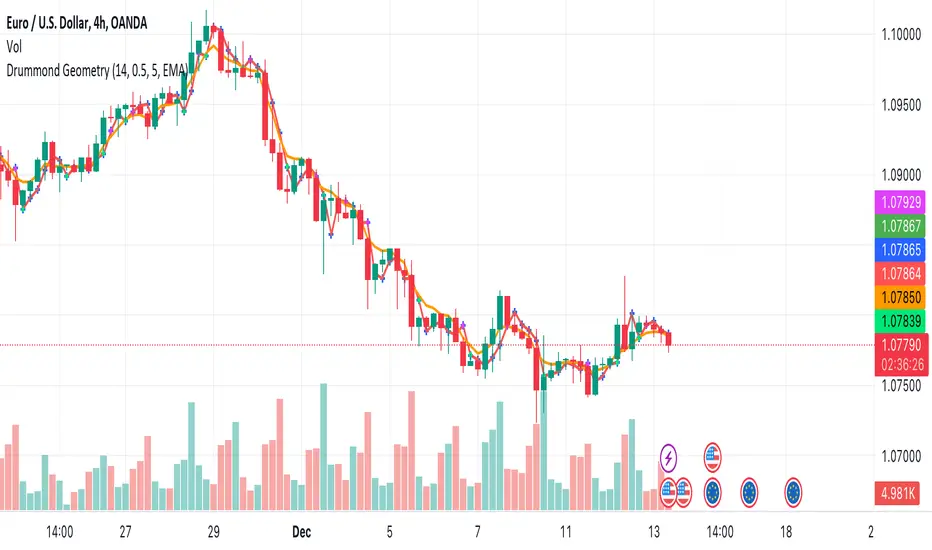OPEN-SOURCE SCRIPT
Updated Drummond Geometry

Drummond geometry is a trading method that uses geometric patterns and moving averages to identify market trends and potential reversals. It was developed by Charles Drummond, a Canadian trader and educator1. The main elements of drummond geometry are:
The PLdot, which is the midpoint of the previous bar’s high and low. It represents the current price level and the direction of the trend. If the PLdot is above the current bar, it indicates an uptrend. If the PLdot is below the current bar, it indicates a downtrend.
The Envelopes, which are parallel lines above and below the PLdot, spaced by a certain percentage of the average true range (ATR). They represent the possible range of price movement and the volatility of the market. If the price breaks out of the envelopes, it signals a possible trend change or continuation.
The Energy Points, which are the intersections of the envelopes and the moving averages. They represent the areas of support and resistance, where the price may bounce or break through. If the price crosses an energy point, it signals a possible entry or exit point.
The PLdot, which is the midpoint of the previous bar’s high and low. It represents the current price level and the direction of the trend. If the PLdot is above the current bar, it indicates an uptrend. If the PLdot is below the current bar, it indicates a downtrend.
The Envelopes, which are parallel lines above and below the PLdot, spaced by a certain percentage of the average true range (ATR). They represent the possible range of price movement and the volatility of the market. If the price breaks out of the envelopes, it signals a possible trend change or continuation.
The Energy Points, which are the intersections of the envelopes and the moving averages. They represent the areas of support and resistance, where the price may bounce or break through. If the price crosses an energy point, it signals a possible entry or exit point.
Release Notes
Drummond geometry is a trading method that uses geometric patterns and moving averages to identify market trends and potential reversals. It was developed by Charles Drummond, a Canadian trader and educator1. The main elements of drummond geometry are:The PLdot, which is the midpoint of the previous bar’s high and low. It represents the current price level and the direction of the trend. If the PLdot is above the current bar, it indicates an uptrend. If the PLdot is below the current bar, it indicates a downtrend.
The Envelopes, which are parallel lines above and below the PLdot, spaced by a certain percentage of the average true range (ATR). They represent the possible range of price movement and the volatility of the market. If the price breaks out of the envelopes, it signals a possible trend change or continuation.
The Energy Points, which are the intersections of the envelopes and the moving averages. They represent the areas of support and resistance, where the price may bounce or break through. If the price crosses an energy point, it signals a possible entry or exit point.
Open-source script
In true TradingView spirit, the creator of this script has made it open-source, so that traders can review and verify its functionality. Kudos to the author! While you can use it for free, remember that republishing the code is subject to our House Rules.
Disclaimer
The information and publications are not meant to be, and do not constitute, financial, investment, trading, or other types of advice or recommendations supplied or endorsed by TradingView. Read more in the Terms of Use.
Open-source script
In true TradingView spirit, the creator of this script has made it open-source, so that traders can review and verify its functionality. Kudos to the author! While you can use it for free, remember that republishing the code is subject to our House Rules.
Disclaimer
The information and publications are not meant to be, and do not constitute, financial, investment, trading, or other types of advice or recommendations supplied or endorsed by TradingView. Read more in the Terms of Use.